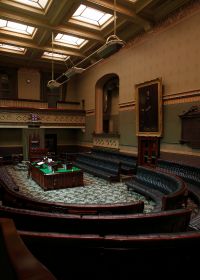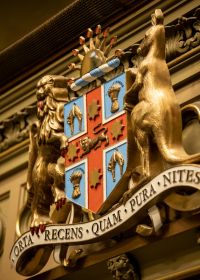The Parliament of New South Wales is the longest sitting legislature in Australia, first sitting in 1824.
The Building
The Parliament of New South Wales occupies the oldest building in the city centre, built as part of the nation's first permanent hospital. The colonnaded central part of the building facing Macquarie Street was completed in 1816 as part of Governor Macquarie's General Hospital – known as the Rum Hospital because its construction was financed by the importation of rum to the colony.
The hospital had a large central building – the main hospital – and two smaller wings that served as Surgeons' Quarters. The central building was demolished and replaced in 1894 by the Sydney Hospital, but the two smaller wings remain. The northern wing, now the colonnaded facade of Parliament House, was originally built as the Principal Surgeon's quarters while the Mint building served as the Assistant Surgeon's quarters.
From 1829 a room on the ground floor of the Surgeons' Quarters was used as the first Legislative Council Chamber. In 1843 the Legislative Council was increased to 36 members, resulting in the need for a larger Chamber. The current Chamber was constructed on the northern end of the building and used by the Legislative Council until 1856.
You can watch this video which provides some more detail on the history of the building, from its early days as the Rum Hospital to the challenges of modern day representative democracy in a heritage building.

| The Chamber
The Legislative Assembly Chamber is Australia’s oldest legislative chamber. Designed by the Colonial Architect, Mortimer Lewis, it has been used by the Legislative Assembly since the establishment of responsible government and a bicameral Parliament in 1856.
The Chamber is rectangular in shape with rows of benches facing each other along each of the longer sides. See the image gallery for a virtual tour of the Chamber and more photos.
Colours and Decorations
The colour used in the Chamber follows the British tradition of green for the Lower House (with red being used for the Upper House). When the Chamber was built the windows were painted green to reduce glare. Contemporary watercolours from this time show the upholstery of the new Chamber as being green, with the walls being a light stone colour. A major feature was the cedar, Gothic styled Speaker's Chair.Later photographs show a larger Chamber, lengthened in 1859 by 15 feet towards the Domain, still with green upholstery. In 1908 the Chamber was redecorated with the addition of a new pressed-metal ceiling to replace the previous plaster; green carpet; walls being repainted and stencilled in sage and emerald greens; and polished cedar features being painted in brown and green tones.
In the 1950s, fluorescent lighting was installed and the Chamber was painted white. Subsequent renovations in the early 1980s restored the Chamber its 1908 appearance.
|
 
|
Symbolism and historical artefacts in the Chamber
The New South Wales Coat of Arms sits above the Speaker’s Chair as a symbol of the sovereignty of New South Wales. Prior to 2007 the Royal Coat of Arms was hung in the Chamber but it was replaced with the New South Wales Coat of Arms in accordance with the State Arms, Symbols and Emblems Act 2004. The NSW State Flag and the Aboriginal Flag hang on the Chamber's northern wall, above the government benches.
The Speaker's Chair was hand carved by a Member of the Assembly, Ninian Melville, in 1886.
A portrait of William Charles Wentworth has hung in the Chamber since 1859. Wentworth was a Member of the pre-responsible Government Legislative Council and, although he was never a Member of the Legislative Assembly, he was integral to the push for responsible government.
A bronze memorial tablet hanging in the Chamber remembers two serving Members – Lieutenant-Colonel George Frederick Braund and Sergeant Edward Rennix Larkin – who were killed in action at Gallipoli in 1915.
|
